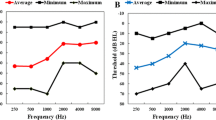Abstract
The study was done to compare speech-evoked auditory brainstem response (ABR) in normal-hearing individuals without diabetes mellitus and normal-hearing individuals with type 2 diabetes mellitus (T2DM). A case-control study design was used to carry out the study. A total of 50 individuals were recruited in the study, divided into two groups. One group consisted of 25 individuals with type 2 diabetes mellitus with normal-hearing and the other group consisted of 25 individuals without diabetes with normal hearing as a control group. The results indicated that the mean latencies and amplitudes was significantly different in the type 2 diabetes mellitus group in comparison to the control group. The amplitude of the F0, F1, higher formants, and RMS values were higher in the control group when compared to the T2DM group. The present study concluded that there is problem in the encoding of speech at the brainstem level despite normal hearing in individuals with type 2 diabetes mellitus.



Similar content being viewed by others
References
Ferreira ACJ, Guimaraes RES, Becker MHG, Goncalves TML, Silva CDL, Crosara PFTB. Metabolic evaluation of patients with labyrinth. Arq Otorrinolaringol. 2000;4:116–7.
Nardo WD, Ghirlanda G, Paludetti P, Cercone S, Saponara C, Ninno MS, et al. Distortion-product otoacoustic emissions and selective sensorineural loss in IDDM. Diabetes Care. 1998;21:1317–21.
Abdllkadiroulu Z, Kaya A, Iihan N. Brainstem auditory evoked potentials in patients with type 2 diabetes mellitus. Turk J Endocrinol Metab. 1999;1:29–32.
Alazzawi LM, Mirza KB. The usefulness of the brainstem auditory evoked potential in the early diagnosis of cranial nerve neuropathy associated with diabetes mellitus. Electromyogr Clin Neurophysiol. 2004;44:87–94.
Swaminathan A, Sambandam R, Bhaskaran M. Evaluation of the auditory effects of hyperlipidaemia and diabetes mellitus by using audiometry. J Clin Diagn Res. 2011;5:1528–32.
Lisowska G, Namysłowski G, Morawski K, Strojek K. Early identification of hearing impairment in patients with type 1 diabetes mellitus. Otol Neurotol. 2001;22:316–20.
Frisina ST, Mapes F, Kim S, Frisina DR, Frisina RD. Characterization hearing loss in aged type II diabetics. Hear Res. 2006;211:103–13.
Moghaddam YJ. Acoustic emissions from the inner ear and brain stem responses in type 2 diabetics. Int J Gen Med. 2011;4:871–4.
Donald M, Bird CE, Lawson JS, Letemenddia FJ, Surridge DH, Varerre P, et al. Delayed auditory brainstem responses in diabetes mellitus. J Neurol Neurosurg Psychiatry. 1981;44:641–4.
Aladag I, Kurt S, Eyibilen A, Guven M, Erkorkmaz U. Early evaluation of auditory dysfunction in patients with type 2 diabetes mellitus. Kulak Burun Bogaz Ihtis Derg. 2008;18:203–10.
Boston JR, Moller AR. Brainstem auditory-evoked potentials. Crit Rev Biomed Eng. 1985;13:97–123.
Russo N, Nicol T, Musacchia G, Kraus N. Brainstem responses to speech syllables. Clin Neurophysiol. 2004;115:2021–203.
Carhart R, Jerger JJ. Preferred method for clinical determination of pure-tone thresholds. J Speech Hear Disord. 1959;24:330–45.
KonradMartin D, Austin DF, Griest S, McMillan GP, McDermott D, Fausti S. Diabetes-related changes in auditory brainstem responses. Laryngoscope. 2010;120:150–8.
Toth F, Varkonyi TT, Rovo L, Lengyel C, Legrady P, Jori J, et al. Investigation of auditory brainstem function in diabetic patients. Int Tinnitus J. 2003;9:84–6.
Kovacic J, Lajtman Z, Oegovi I, Kneevi P, Cari T, Vlai A. Investigation of auditory brainstem function in elderly diabetic patients with presbycusis. Int Tinnitus J. 2009;15:79–82.
Tandon OP, Verma A, Ram BK. Cognitive dysfunction In NIDDM: P 3 event related evoked potential study. Indian J Physiol Pharmacol. 1999;43:383–8.
Alvarenga KDF, Duarte JL, Silva DPC, Pesse RSA, Negrato CA, Costa OA. Cognitive P300 potential in subjects with diabetes mellitus. Braz J Otorhinolaryngol. 2005;71:202–7.
Maia CAS, Campos CAH. Diabetes mellitus as etiological factor of hearing loss. Braz J Otorhinolaryngol. 2005;71:208–14.
Author information
Authors and Affiliations
Corresponding author
Rights and permissions
About this article
Cite this article
Gupta, S., Bhat, J.S. & Kumar, K. Subcortical processing of speech in individuals with type 2 diabetes mellitus. Int J Diabetes Dev Ctries 35, 327–331 (2015). https://doi.org/10.1007/s13410-015-0299-y
Received:
Accepted:
Published:
Issue Date:
DOI: https://doi.org/10.1007/s13410-015-0299-y



